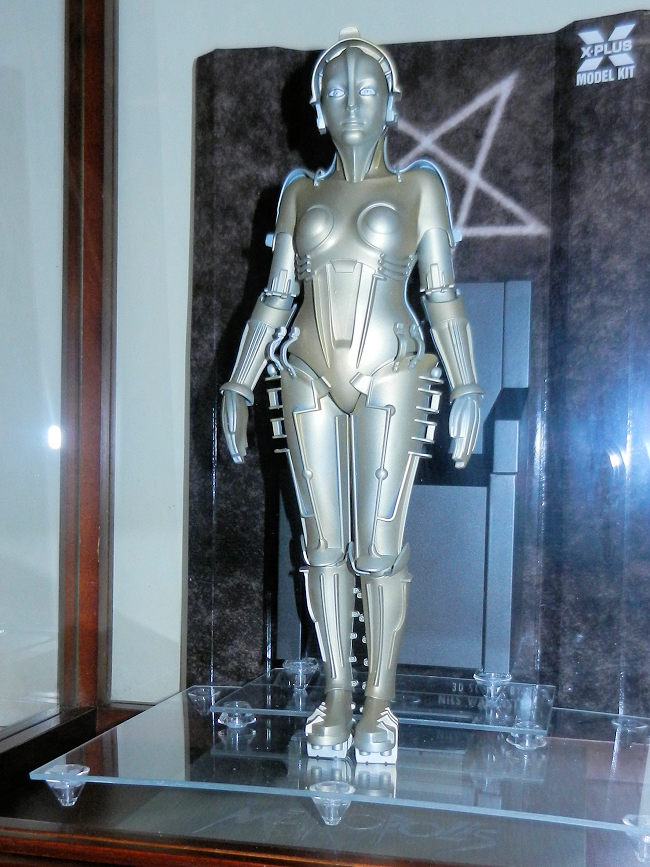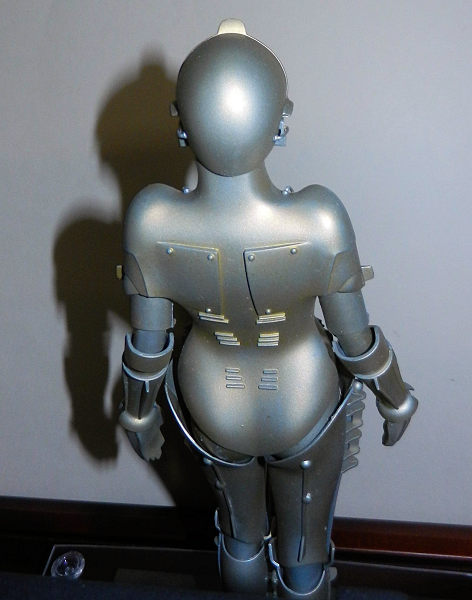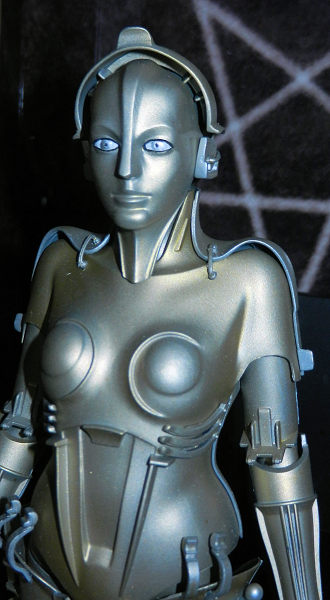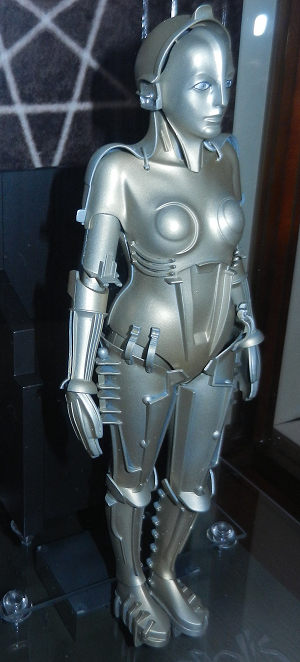
| KIT #: | 411-200138T |
| PRICE: | CAD$105.00 |
| DECALS: | None |
| REVIEWER: | Pablo Calcaterra |
| NOTES: | The mother of all good S-F movies |

| HISTORY |
Fritz Lang embarked on the monumental project based on his wife’s book
Metropolis. His idea was to show that Germany could compete with Hollywood. It
took 17 months to film it in 1925/1926
and was released in 1927. The
amount of money spent on the movie put the already struggling UFA studios in a
worse situation created by a very bad deal made with Paramount a few years
before (effectively though 40 German films were to be shown in the US in
exchange for 40 US films shown in Germany the North Americans reserved the right
to veto the German films to be shown in their country…and so they did…putting
the Germans  deeper
into debt while losing their domestic market to Paramount…) Metropolis cost 4
times more than what it was budgeted and was not able to cover the costs when it
was shown in theaters. Reviews were anything but stellar. People did not like
the length of the movie and how complex it was. The film was trimmed to make it
more appealing to the masses but at the time it still was a flop.
deeper
into debt while losing their domestic market to Paramount…) Metropolis cost 4
times more than what it was budgeted and was not able to cover the costs when it
was shown in theaters. Reviews were anything but stellar. People did not like
the length of the movie and how complex it was. The film was trimmed to make it
more appealing to the masses but at the time it still was a flop.
One of the most iconic characters of the movie is the robot that in the book is called Futura or Parody. Otherwise it is also known as Maschinenmensch (man-machine) or incorrectly Maria or False Maria after the character played by Brigitte Helm.
To make the robot Walter Schulze-Mittendorff evaluated many materials but they were too heavy for Helm to wear (metal, wood, etc). Then he was told about a new material called Plastic Wood. A full body plaster cast of the actress was made and the material was laminated and flattened over the cast. Once the parts were made, they were sprayed with aluminum paint followed by several coats of a clear varnish that delivered a golden hue to the robot.
It took 9 days to film the robot sequences. Poor Helm suffered cuts and bruises donning the uncomfortable and movement restricting costume. Besides it was very hot and cumbersome. She had to be cooled down with electric hair dryers thru the openings of the costume. Members of the staff would drop coins in the costume she was wearing and the very young actress (17 to 18 years old at the time) would use those coins to buy chocolate at the cafeteria in the studio…Once she complained about being in the robot while the robot was not required to move but Fritz Lang told her that what mattered was that HE knew it was her inside the costume…not surprisingly Helm said that this, her first film, was her most difficult one and that she would never work under Lang again (he wanted extreme realism so her hair was actually pulled during a scene and when the robot is burned she almost caught fire too!)
In 2001, Metropolis was inscribed on UNESCO's Memory of the World Register, the first film thus distinguished. The film has inspired visually many modern sci-fi classics like Blade Runner, Brazil, Stars Wars…and many pop female singers have used costumes inspired in the robot.
| THE KIT |
 It comes in
a very sturdy box with excellent instructions. Besides all the parts to build
the robot there is the large chair in which she sat, the floor (in two levels
but more about this later) and a cardboard base that also features the back wall
with the inverted star as seen in the movie.
It comes in
a very sturdy box with excellent instructions. Besides all the parts to build
the robot there is the large chair in which she sat, the floor (in two levels
but more about this later) and a cardboard base that also features the back wall
with the inverted star as seen in the movie.
Parts are molded in silver (robot), brown (chair) and clear (legs of chair and floor levels) but the gates are huge. There are extra parts for those small ones in case you break them while removing them from the trees…
Once I inspected the kit I tried to put it back in the box again…and it was impossible no matter the configuration I tried. That tells you how tight the box is.
| CONSTRUCTION |
The biggest time consuming part was to cut the parts from the trees and sanding what was left of the gates. Otherwise following the clear instructions was enough.
Before assembling the model I painted all the parts using Vallejo light grey primer. Then I sprayed Vallejo Model Air Chrome followed by a very diluted mix of Vallejo Gold (using their Thinner and water). When I was satisfied with the golden hues of the paint I added an extremely light coat of Vallejo Bronze in some areas. No washes were applied because the robot was very clean and because there was no need to highlight any area: it is very 3Dish with practically no flat areas. Besides there is no mention of such a technique or similar being used on the original robot.
The eyes were painted with white, the iris in silver and the pupil in black. The eyeliner was done using dark grey Vallejo primer (all information about colour of the robot comes from an interview to Schulze-Mittendorff)
 Once the
paint had dried, I glued everything together. Fit is perfect and the connecting
pins are extremely tight. I tried to test fit a couple of parts and had a hell
of a time trying to pull them apart fearing to damage them.
Once the
paint had dried, I glued everything together. Fit is perfect and the connecting
pins are extremely tight. I tried to test fit a couple of parts and had a hell
of a time trying to pull them apart fearing to damage them.
The seat it’s very easy to assemble, with a bit of putty required in the union of the 2 parts (this being conveniently on the back of the seat). Then the seat received a coat of gloss black mixed with Aluminum (all Vallejo). The text behind the seat was highlighted drybrushing Vallejo Chrome.
The problems with the base parts are that:
They are not clear as seen in the movie and
The geometry is wrong. They should be wide but the kit’s are projected forward (deep).
Using clear sheets of plastic I cut the 2 different levels. I had to make them a bit smaller than what you see in the film for them to fit in the glass box that I had available.
 I decided
to use base that has the name of the movie and glue it under the main floor. I
had to cut out a couple of centimeters from the back for it to fit the display
case. This part of the “floor” was painted with dark grey Vallejo Primer
followed by a mix of 10 parts Vallejo Mid Stone and 3 parts flat Black. Then
with very diluted black Iightly I sprayed diagonal lines to resemble shadows on
the base/floor. The word Metropolis was painfully brush painted (I had to do
some retouches mixing the base colour again). I had to add a rectangle of white
plastic to cover the gap where the top brown floor sits. Otherwise it would have
left hole visible under the seat clear floor level. This part I painted in
Vallejo Chrome with another coat of diluted black diagonal lines following the
same orientation as those applied to the main base.
I decided
to use base that has the name of the movie and glue it under the main floor. I
had to cut out a couple of centimeters from the back for it to fit the display
case. This part of the “floor” was painted with dark grey Vallejo Primer
followed by a mix of 10 parts Vallejo Mid Stone and 3 parts flat Black. Then
with very diluted black Iightly I sprayed diagonal lines to resemble shadows on
the base/floor. The word Metropolis was painfully brush painted (I had to do
some retouches mixing the base colour again). I had to add a rectangle of white
plastic to cover the gap where the top brown floor sits. Otherwise it would have
left hole visible under the seat clear floor level. This part I painted in
Vallejo Chrome with another coat of diluted black diagonal lines following the
same orientation as those applied to the main base.
 I drilled
passing/attaching holes on the main clear floor for the pegs under the robot’s
shoes to attach it to (I had discarded the brown floor where the robot stands
because as mentioned above it does not have the correct geometry).
I drilled
passing/attaching holes on the main clear floor for the pegs under the robot’s
shoes to attach it to (I had discarded the brown floor where the robot stands
because as mentioned above it does not have the correct geometry).
Note: there’s not enough plastic at the bottom of the seat for the clear legs to be attached to. I had to put some plasticard under the seat to create a more firm/stable surface onto which the legs were then glued.
I used a very good image of the robot standing on the floor/platforms to configure the correct legs to be used at each level (from seat to top level, from top level to main level).
Once everything was painted, cut, glued it was a matter of putting the robot together in the platform along with the seat. And with that it was done!
In 10 days the model was finished. A couple were spent cutting the pieces free from the trees and cleaning the gates. Five days were used to paint and assemble the robot. And it took 3 days to create the different levels of the floor and put the seat together and paint it along the base.
| CONCLUSIONS |
An excellent kit that faithfully represents the classic robot of Metropolis.
| REFERENCE |
Wikipedia
https://www.filmportal.de/en/topic/the-crisis-parufamet-megalomania-and-metropolis
29 July 2024
Copyright ModelingMadness.com. All rights reserved. No reproduction in part or in whole without express permission from the editor.
If you would like your product reviewed fairly and fairly quickly, please contact the editor or see other details in the Note to Contributors.